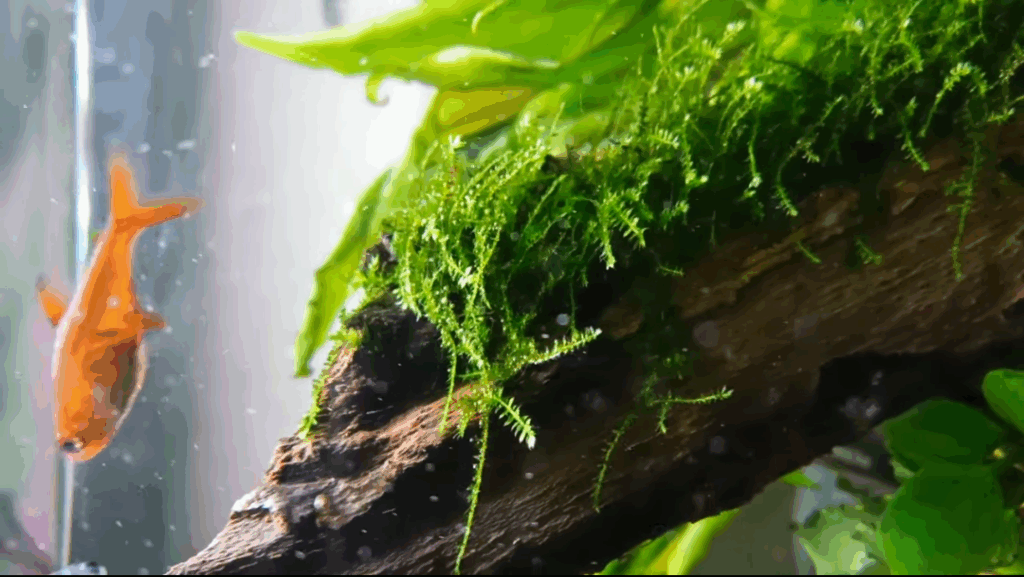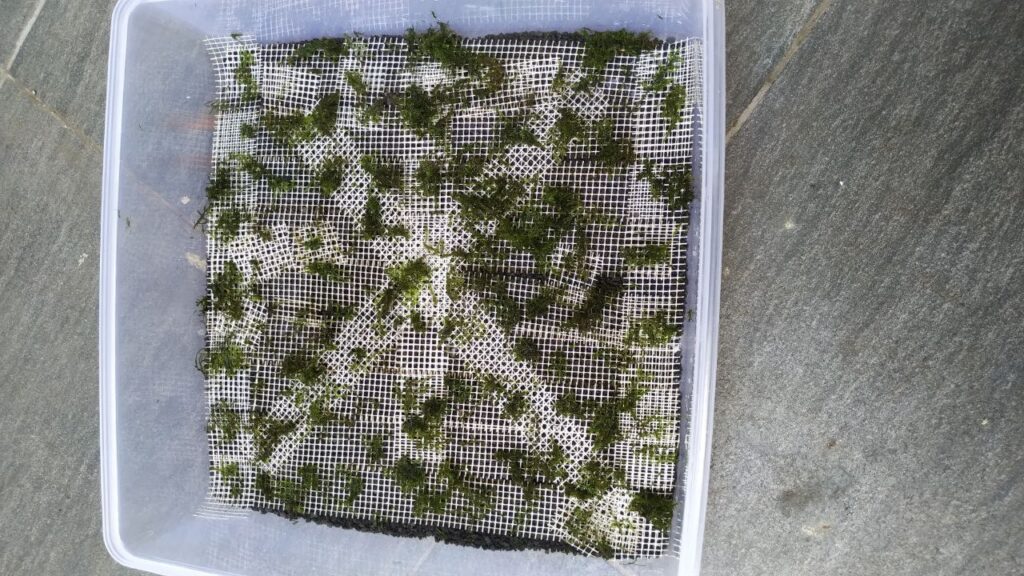Taxonomy and Classification
- Kingdom: Plantae
- Division: Bryophyta
- Class: Bryopsida
- Order: Hypnales
- Family: Hypnaceae
- Genus: Taxiphyllum
- Species: T. barbieri
Note: Previously misidentified as Vesicularia dubyana, T. barbieri is now confirmed as a distinct species, commonly referred to in the aquarium trade as Java Moss.
Morphological Characteristics

- Structure: Lacks true roots; anchors using rhizoids.
- Leaf Form: Small, overlapping, lanceolate leaves arranged in an irregular, branching pattern.
- Growth Habit: Spreads horizontally and vertically; can grow attached to surfaces or float freely.
- Color: Healthy specimens are bright to deep green. Yellowing indicates suboptimal conditions.
Habitat and Environmental Tolerance
- Native Range: Southeast Asia; commonly found in shaded freshwater streams and riverbanks.
- Temperature: 20–30°C (68–86°F)
- pH Range: 5.0–8.0
- Water Hardness: Soft to moderately hard
- Lighting: Tolerates low to moderate intensity; high light may promote algae growth.
- CO₂ Requirements: Not essential, but moderate supplementation improves growth rate and density.
Cultivation and Propagation

- Substrate: Not required. Attaches to rocks, wood, plastic, and other inert surfaces.
- CO₂/Fertilizer Use: Optional. Liquid fertilizers enhance growth but are non-essential.
- Propagation:
- Mechanical Division: Trimming and replanting sections.
- Passive Spread: Fragments that detach can reattach and grow independently.
- Growth Rate: Slow to moderate, depending on environmental stability and nutrients.
- Trimming: Regular trimming maintains shape and prevents excessive density.
Applications in Aquascaping and Ecology
- Tank Integration:
- Attaches to driftwood, rocks, mesh, or floats freely.
- Functions in foregrounds, midgrounds, or floating setups.
- Utility:
- Provides cover for fry and shrimp.
- Facilitates colonization by biofilm and beneficial bacteria.
- Offers spawning substrate for some fish species.
- Filtration Role:
- Assists in nutrient uptake (ammonia, nitrites, nitrates).
- Indirectly inhibits algae through nutrient competition.
- Oxygenation: Photosynthesizes during light periods, producing dissolved oxygen.
Maintenance and Troubleshooting
- Common Issues:
- Yellowing/Browning: Caused by poor lighting, nutrient deficiency, or old growth.
- Melting: Occurs under temperature stress or poor water quality.
- Algae Growth: Often a result of excessive light or high organic load.
- Revival Protocol:
- Remove deteriorated tissue.
- Correct water parameters.
- Improve lighting and flow.
- Add fertilizer or CO₂ if needed.
- Disinfection (Optional): 1:10 bleach dip for ≤30 seconds followed by dechlorination.
Compatibility
- Fish: Compatible with most freshwater species.
- Betta: Ideal for nest support.
- Guppies: May nibble but typically non-destructive.
- Shrimp: Do not consume the moss itself but graze on attached biofilm.
- Tank Dynamics: Can dominate if untrimmed, but easily controlled via manual removal.
Limitations
- Marine Incompatibility: Will not survive in brackish or saltwater conditions.
- Sunlight: Direct sunlight can promote algae growth and cause stress.
- Substrate Burial: Should not be buried; degrades if covered.
Use in Non-Aquatic Settings
- Terrarium Suitability: Can survive in high-humidity, semi-submerged setups, but growth is limited compared to aquatic environments.
Benefits Summary
| Function | Description |
|---|---|
| Water Purification | Absorbs ammonia, nitrites, and nitrates. |
| Oxygen Production | Contributes to oxygen levels via photosynthesis. |
| Habitat Creation | Provides microhabitats for fry, shrimp, and microbial life. |
| Low Maintenance | Tolerant of wide water parameters and lighting conditions. |
Frequently Asked Questions
- Does Java Moss need CO₂?
No. Growth improves with it, but it’s not a requirement. - Does it require fertilizer?
No, but liquid fertilizers can promote faster, denser growth. - Can it grow on plastic or driftwood?
Yes. It adheres to most surfaces via rhizoids. - Can Java Moss live without substrate?
Yes. It thrives when attached or floating. - Will it take over the tank?
Only if left untrimmed. It is easily managed with scissors.
Java Moss (Taxiphyllum barbieri) is one of the most versatile and resilient aquatic plants available to aquarists. Its adaptability to a wide range of water parameters, combined with its ecological benefits and low-maintenance nature, makes it an ideal choice for both novice and experienced hobbyists. Its ability to improve water quality, oxygenate the tank, and support aquatic life firmly establishes it as a foundational species in freshwater aquascaping.